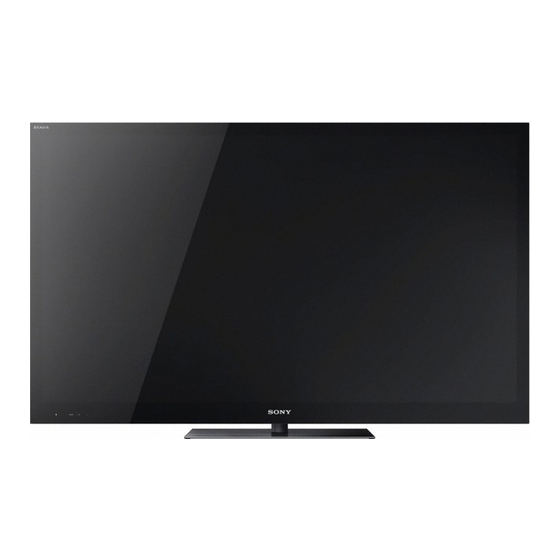
Summarization of Contents
Precautions and Handling
Viewing the TV Safely
Guidelines for watching TV, especially 3D content, and headphone usage to prevent discomfort or hearing damage.
LCD Screen Care and Properties
Information about LCD screen characteristics, potential pixel issues, and proper handling to avoid damage.
i-Manual Contents and Usage
How to Use the i-Manual
Instructions on accessing and navigating the i-Manual feature for detailed explanations.
BRAVIA TV Features Overview
Overview of specific features offered by BRAVIA TVs, such as 3D, Internet Video, and Sync.
Watching TV Functions
Topics related to viewing content on the TV, including features like Wide Mode and Picture Mode.
Settings and Home Menu Navigation
How to access and use TV settings and the Home Menu for customization.
Using Other Equipment and Internet
Connecting and using external devices like DVD players and internet services.
Remote Control Parts Description
Identification of TV remote control parts and indicators for basic operation.
Troubleshooting Common Issues
Guidance on resolving common TV issues and problems.
Index and Bookmarks
Alphabetical listing of topics and functionality for saving frequently accessed pages.
Getting Started with Your TV
Checking Included Accessories
List of items included with the TV package, such as remote, batteries, and stand.
Inserting Batteries into the Remote
Step-by-step guide for installing batteries correctly in the remote control.
Attaching the Table-Top Stand
Instructions for attaching the TV's stand to the unit, with model-specific notes.
Adjusting the TV Viewing Angle
Angle Adjustment (Swivel)
How to swivel the TV on its stand for optimal viewing angles.
Angle Adjustment (Tilt)
How to tilt the TV on its stand for optimal viewing angles.
Connecting Antennas, Cables, and VCRs
Connecting an Antenna or Cable
Guide to connecting broadcast or cable TV antennas to the TV.
Connecting Set-Top Boxes/Recorders via HDMI
Instructions for connecting external devices like set-top boxes or DVD recorders via HDMI.
Preventing TV Toppling and Cable Bundling
Preventing the TV from Toppling Over
Instructions for securing the TV to prevent it from falling.
Bundling Cables Neatly
Guide on how to organize and bundle TV cables for a tidy setup.
Using Your BRAVIA TV
Watching TV Basics
Basic steps for turning on the TV and selecting channels.
Using the Digital Electronic Programme Guide
How to access and use the TV's program guide for channel information.
Remote Control Overview
Remote Control Buttons Explained
Explanation of the functions of different buttons on the remote control.
i-Manual Screen Navigation and Features
Using Bookmarks in i-Manual
How to bookmark and access saved pages within the i-Manual.
Memorizing the Last Displayed Page
How the i-Manual remembers and recalls the last viewed page.
Network Setup
Preparing a Wired Network Connection
Instructions for setting up a wired internet connection for the TV.
Preparing a Wireless LAN Connection
Guide to setting up a wireless internet connection for the TV.
Setting Up Internet Connection
Wireless LAN Setup Configuration Types
Overview of different wireless network setup configurations based on router compatibility.
Type 1: Secured Network with WPS
Configuration for a secure wireless network using Wi-Fi Protected Setup (WPS).
Type 2: Secured Network without WPS
Configuration for a secure wireless network without Wi-Fi Protected Setup (WPS).
Network Status and Troubleshooting
Viewing Network Status
How to confirm the current network status of the TV.
Troubleshooting Internet Connection Issues
Steps to diagnose and resolve failures when connecting to the internet.
Adjusting Server Display Settings
How to select and display home network servers on the Home Menu.
Additional Information Section
Troubleshooting Common TV Issues
Solutions for common problems encountered with the TV, such as no picture or sound.
Installing Accessories: Wall-Mount Bracket
SU-WH500 Wall-Hanging Bracket Installation
Steps for installing the SU-WH500 wall-hanging bracket, including parts and precautions.
SU-WL700/SU-WL50B Wall-Mount Bracket Precautions
Important safety and installation notes for SU-WL700/SU-WL50B brackets.
SU-WL50B Mounting Hook Installation
Guide for attaching mounting hooks for the SU-WL50B bracket to the TV.
SU-WL50B Screw and Hook Location Guide
Diagram and table showing screw and hook positions for SU-WL50B bracket.
SU-WL50B TV Installation Dimensions Table
Table detailing dimensions for installing SU-WL50B bracket at different angles.
Wall Mounting Safety Warning
Critical safety warning regarding wall strength for TV mounting.
Safety Information Section 1
Installation and Setup Safety Guidelines
General instructions for safe TV installation and setup to prevent hazards.
Transporting Precautions
Precautions to take when moving the television to prevent damage or injury.
Ventilation Requirements
Requirements for proper airflow around the TV to prevent overheating.
AC Power Cord and Outlet Safety
Safety guidelines for using the AC power cord and outlet to prevent fire or shock.
Prohibited Usage and Locations
Locations and situations where TV usage is not recommended to avoid malfunction or hazards.
Safety Precautions and Conditions
Environmental Conditions and Precautions
Environmental conditions to avoid for TV operation, such as heat, humidity, or dust.
Critical Problem Actions
Immediate actions for critical issues like power cord damage or dropped TV.
Situational Safety Measures
Situational precautions, like unplugging during lightning storms.
Broken Screen Safety Advice
Safety advice if the TV screen cracks or breaks, including avoiding contact.
TV Usage When Not In Use
Recommendations for unplugging the TV when not in use for environmental and safety reasons.
Child Safety Guidelines
Safety measures related to children and the TV, like securing accessories.
Safety Information and Problem Handling
Environmental Hazards and Precautions
Environmental conditions to avoid for TV operation, such as heat, humidity, or dust.
Critical Problem Actions
Immediate actions for critical issues like power cord damage or dropped TV.
Situational Safety Measures
Situational precautions, like unplugging during lightning storms.
Broken Screen Safety Advice
Safety advice if the TV screen cracks or breaks, including avoiding contact.
TV Usage When Not In Use
Recommendations for unplugging the TV when not in use for environmental and safety reasons.
Child Safety Guidelines
Safety measures related to children and the TV, like securing accessories.









Need help?
Do you have a question about the KDL-55HX920 and is the answer not in the manual?
Questions and answers